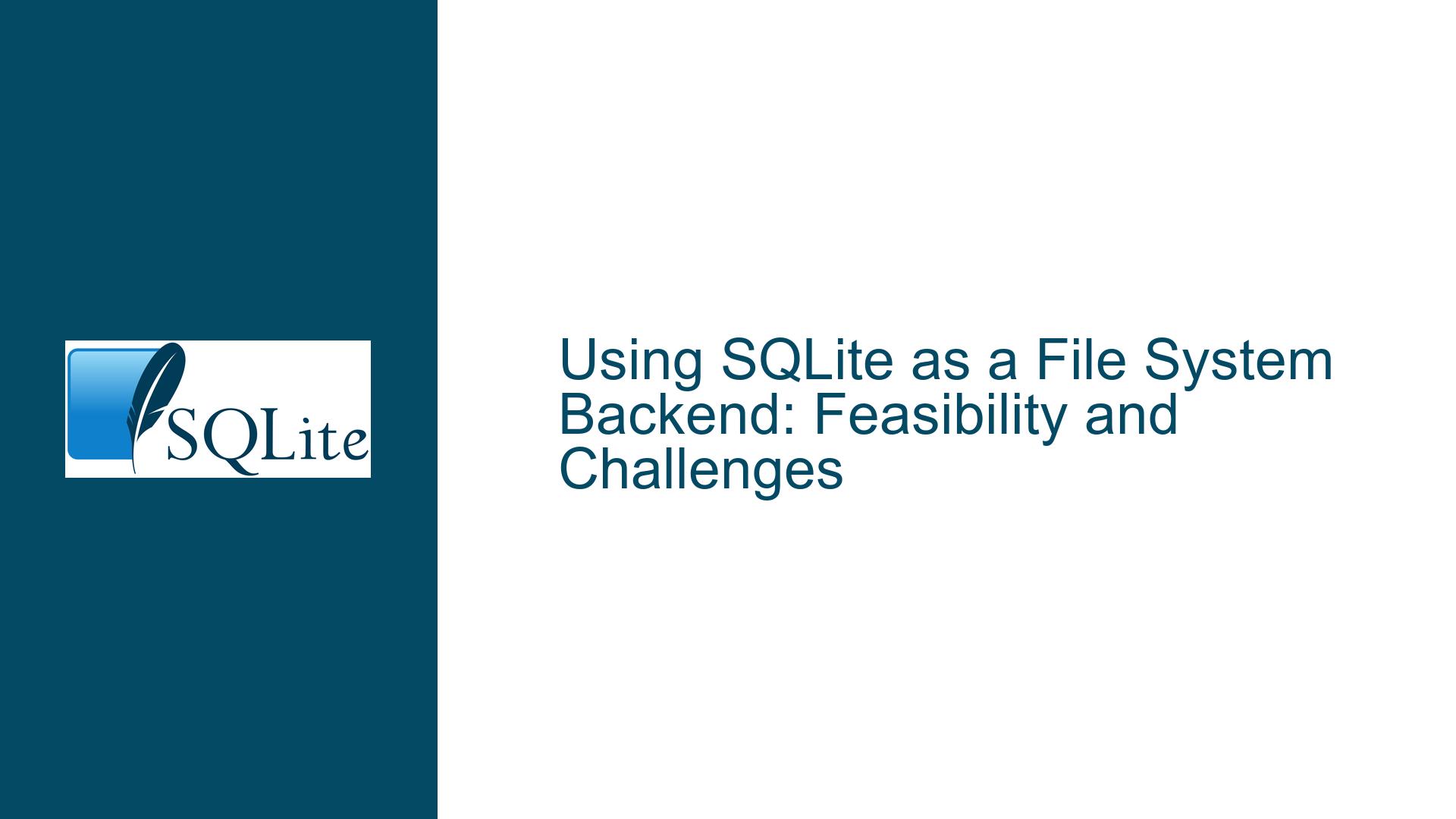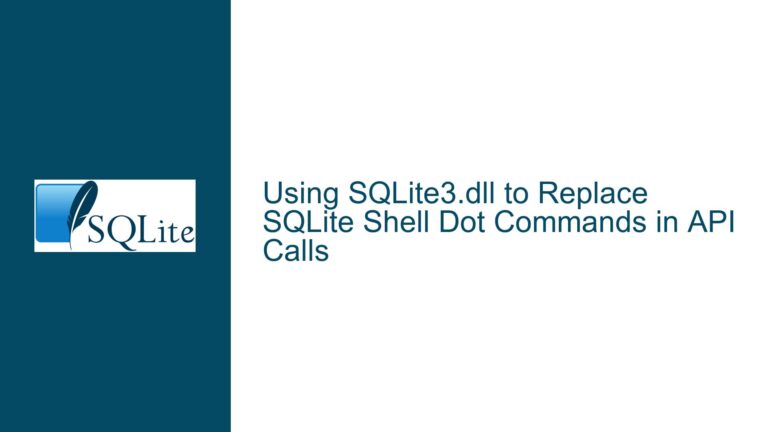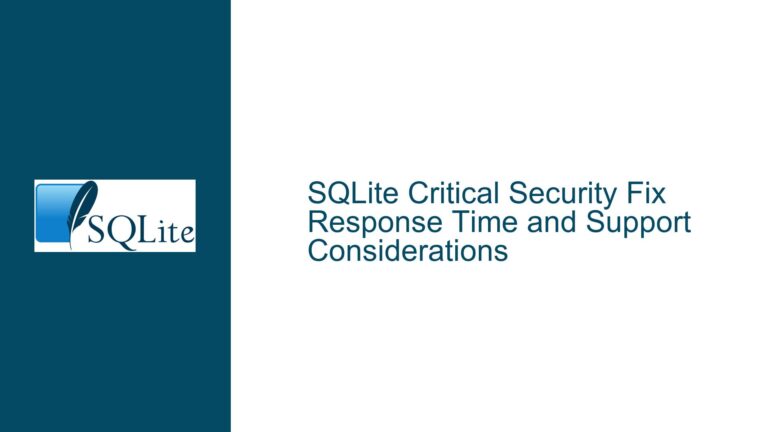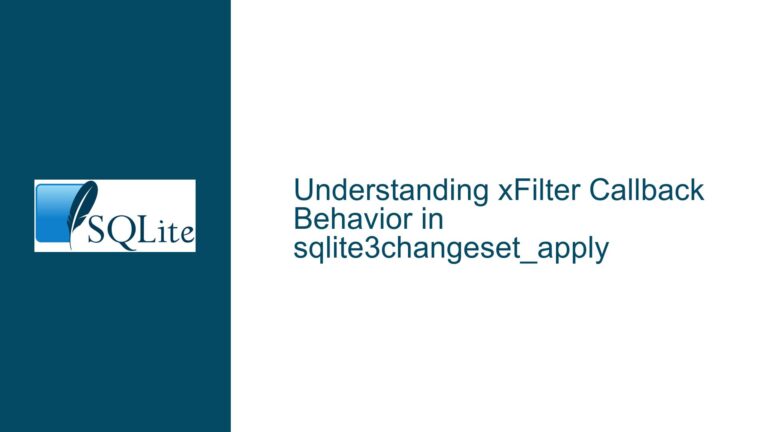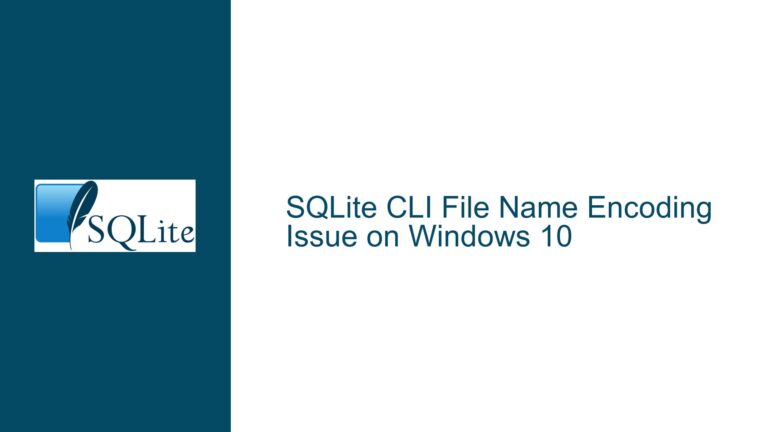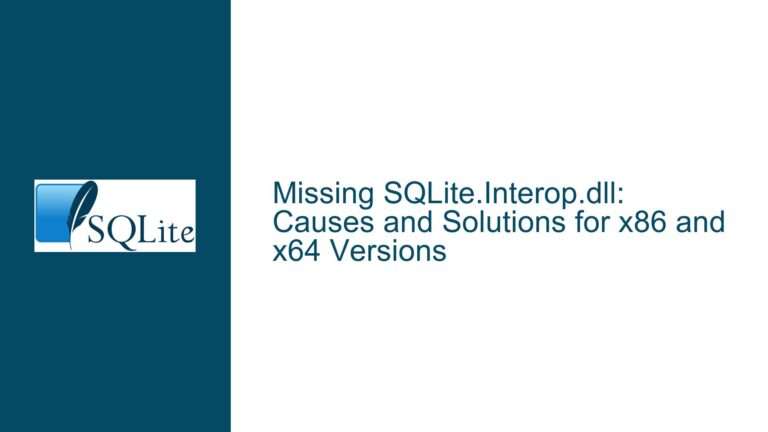Using SQLite as a File System Backend: Feasibility and Challenges
Architectural Considerations for Implementing SQLite as a File System
The concept of using SQLite as a file system back-end in a custom operating system involves leveraging SQLite’s database engine to manage file storage, metadata, and I/O operations. This approach replaces traditional file system structures (e.g., inodes, block allocation tables) with SQL tables and queries. The proposal includes storing Write-Ahead Logging (WAL) files on a separate partition, using SQLite’s Virtual File System (VFS) layer to translate database operations into low-level disk commands, and exposing SQL queries as the primary interface for file access.
Key advantages highlighted include SQLite’s ACID compliance, atomic transaction handling, built-in backup mechanisms, and elimination of manual data structure management (e.g., trees, logs). However, this design introduces challenges related to performance, concurrency, and alignment with file system workloads. Historical precedents like WinFS and BeFS demonstrate the complexity of integrating database-like query capabilities with file system operations, while projects like libsqlfs illustrate practical implementations of SQLite-based file systems.
The core question revolves around whether SQLite’s architecture can efficiently handle the I/O patterns, latency requirements, and scalability demands of a general-purpose file system. Traditional file systems optimize for sequential/random access, block management, and metadata operations—areas where SQLite’s page-oriented storage and transactional model may introduce overhead.
Technical Limitations and Performance Trade-Offs
Concurrency and Locking Mechanisms
SQLite employs a writer-exclusive locking model, allowing only one write transaction at a time. While WAL mode improves concurrency by enabling readers to coexist with a single writer, this design may struggle with highly parallel write workloads typical in multi-user or multi-threaded environments. File systems often require fine-grained locking (e.g., per-file or per-block), whereas SQLite’s database-level locking could create contention.
Read-Ahead and Streaming Limitations
SQLite lacks built-in read-ahead optimizations, which are critical for sequential file access (e.g., loading large media files). Traditional file systems pre-fetch data blocks to reduce latency, but SQLite’s page cache is designed for random access patterns. Streaming large BLOBs via SQLite’s sqlite3_blob interface incurs overhead from page-level I/O and transaction boundaries.
VFS Layer Complexity
Implementing a custom VFS driver to interface with raw storage requires replicating low-level operations (e.g., sector writes, wear leveling for SSDs) that are abstracted away in traditional file systems. SQLite’s VFS expects block-device semantics, which may conflict with storage hardware characteristics (e.g., NVMe’s parallelism).
Metadata Representation
File systems manage metadata (permissions, timestamps, extended attributes) as fixed-size structures, enabling fast in-place updates. Storing metadata in SQL tables introduces row-based overhead and index traversal costs for common operations like ls or stat.
Transaction Overhead
ACID guarantees impose write-ahead logging and fsync operations, which degrade performance for small, frequent writes (e.g., appending to log files). Journaling file systems mitigate this with batched updates, but SQLite’s transactional model enforces stricter durability by default.
Strategies for Mitigation and Implementation
Custom VFS Driver Optimization
Develop a minimal VFS driver that bypasses the OS file layer and directly interfaces with disk sectors. Use SQLite’s sqlite3_io_methods to implement sector-aligned reads/writes, ensuring compatibility with storage hardware. For SSDs, align writes with erase block sizes to reduce wear.
Example VFS methods:
static int xWrite(sqlite3_file *file, const void *pBuf, int amt, sqlite3_int64 offset){
struct DiskHandle *p = (struct DiskHandle*)file;
return disk_driver_write(p->disk, offset, amt, pBuf);
}
Hybrid Metadata and Data Storage
Store file contents as BLOBs in a table with inlined metadata columns (e.g., name TEXT, size INT, mtime DATETIME). Use covering indexes to accelerate directory listings:
CREATE INDEX idx_dir ON files(parent_id, name) INCLUDE (size, mtime);
Leverage SQLite’s WITHOUT ROWID tables for clustered indexes, reducing lookup latency for hierarchical paths.
Read-Ahead and Caching
Implement a user-defined page cache that anticipates sequential access. Extend SQLite’s sqlite3_pcache methods to pre-fetch adjacent pages when scanning BLOBs. For example, detect sequential reads of a file’s BLOB and issue asynchronous read requests for subsequent pages.
Concurrency Tuning
Enable WAL mode (PRAGMA journal_mode=WAL;) to allow concurrent readers during writes. Partition the database into shards based on directory hierarchies, distributing writes across multiple .db files to mitigate lock contention.
Streaming API Integration
Use sqlite3_blob_open for random access to file content without loading entire rows into memory. Combine with mmap-based I/O (via sqlite3_config(SQLITE_CONFIG_MMAP_SIZE)) to map large BLOBs directly into the process address space.
Benchmarking Against libsqlfs
Analyze the performance of libsqlfs, which implements POSIX-like file operations atop SQLite. Compare open()/read() latency with ext4 or NTFS using fio benchmarks. Identify bottlenecks in SQL query planning (e.g., EXPLAIN QUERY PLAN for metadata operations) and optimize schema design.
Leveraging SQLite’s Backup API
Use online backups (sqlite3_backup_init) for file system snapshots. Schedule incremental backups to a separate partition, leveraging SQLite’s ability to attach multiple databases:
ATTACH '/snapshots/backup.db' AS backup;
INSERT INTO backup.files SELECT * FROM main.files WHERE mtime > last_backup;
Kernel Space Considerations
If running SQLite in kernel space, ensure memory allocators and mutexes are compatible with interrupt context. Replace SQLite’s default malloc with a slab allocator to prevent fragmentation. Disable features like extension loading and dynamic memory limits to reduce attack surface.
Failure Recovery
Implement a fsck-like tool that checks database integrity using PRAGMA integrity_check and reconstructs corrupted indices via REINDEX. Use WAL checkpointing (PRAGMA wal_checkpoint(TRUNCATE)) to minimize recovery time after crashes.
By addressing these challenges through schema optimization, VFS customization, and workload-specific tuning, SQLite can serve as a viable foundation for specialized file systems where ACID properties and SQL queryability outweigh raw throughput demands. However, general-purpose adoption requires careful evaluation against performance-critical use cases.
